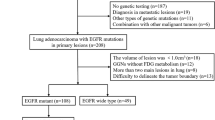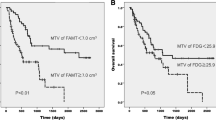Abstract
Purpose
We investigated fluorine-18 fluorodeoxyglucose positron emission tomography/computed tomography (FDG PET/CT)-assessed metabolic tumor volume (MTV) and total lesion glycolysis (TLG) as prognostic factors in lung adenocarcinoma patients.
Methods
This retrospective study included 106 patients (19 stage I/II and 87 stage III/IV lung adenocarcinoma) who underwent FDG PET/CT before treatment. Standardized uptake value (SUV), MTV, and TLG (MTV × mean SUV) of each malignant lesion were measured. Whole MTV and whole TLG were the summation of all the MTV and TLG values in each patient. Survival analysis and FDG PET/CT parameters regarding epidermal growth factor receptor (EGFR) gene mutation status were evaluated.
Results
Univariate survival analysis of stage III/IV patients identified high whole MTV (≥90), high whole TLG (≥600), and stage IV as significant predictors of poor progression-free survival. For overall survival, high whole MTV (≥90), high whole TLG (≥600), EGFR mutation-negative, and stage IV were significant poor prognostic predictors. After multivariate survival analysis, high whole MTV (P = 0.001), high whole TLG (P = 0.027), and stage IV (P = 0.006) were independent predictors of poor progression-free survival. High whole MTV (P < 0.001), high whole TLG (P = 0.001), and EGFR mutation-negative (P = 0.001) were independent prognostic predictors for poor overall survival. In a survival analysis of stage I/II patients, none was an independent prognostic predictor. No significant differences were found in FDG PET/CT parameters for EGFR mutation-negative and EGFR mutation-positive patients.
Conclusions
Assessment of MTV and TLG by FDG PET/CT in advanced lung adenocarcinoma patients provides useful information regarding prognosis.




Similar content being viewed by others
References
Agarwal M, Brahmanday G, Bajaj SK, Ravikrishnan KP, Wong CY (2010) Revisiting the prognostic value of preoperative (18)F-fluoro-2-deoxyglucose ((18)F-FDG) positron emission tomography (PET) in early-stage (I & II) non-small cell lung cancers (NSCLC). Eur J Nucl Med Mol Imaging 37(4):691–698. doi:10.1007/s00259-009-1291-x
Are C, Hsu JF, Ghossein RA, Schoder H, Shah JP, Shaha AR (2007) Histological aggressiveness of fluorodeoxyglucose positron-emission tomogram (FDG-PET)-detected incidental thyroid carcinomas. Ann Surg Oncol 14(11):3210–3215. doi:10.1245/s10434-007-9531-4
Caudle AS, Gonzalez-Angulo AM, Hunt KK, Liu P, Pusztai L, Symmans WF et al (2010) Predictors of tumor progression during neoadjuvant chemotherapy in breast cancer. J Clin Oncol 28(11):1821–1828. doi:10.1200/JCO.2009.25.3286
Chao F, Zhang H (2012) PET/CT in the staging of the non-small-cell lung cancer. J Biomed Biotechnol 2012:783739. doi:10.1155/2012/783739
Chen HH, Chiu NT, Su WC, Guo HR, Lee BF (2012) Prognostic value of whole-body total lesion glycolysis at pretreatment FDG PET/CT in non-small cell lung cancer. Radiology 264(2):559–566. doi:10.1148/radiol.12111148
Cufer T, Ovcaricek T, O’Brien ME (2013) Systemic therapy of advanced non-small cell lung cancer: major-developments of the last 5-years. Eur J Cancer 49(6):1216–1225. doi:10.1016/j.ejca.2012.11.021
Downey RJ, Akhurst T, Gonen M, Vincent A, Bains MS, Larson S et al (2004) Preoperative F-18 fluorodeoxyglucose-positron emission tomography maximal standardized uptake value predicts survival after lung cancer resection. J Clin Oncol 22(16):3255–3260. doi:10.1200/JCO.2004.11.109
Garin E, Le Jeune F, Devillers A, Cuggia M, de Lajarte-Thirouard AS, Bouriel C et al (2009) Predictive value of 18F-FDG PET and somatostatin receptor scintigraphy in patients with metastatic endocrine tumors. J Nucl Med 50(6):858–864. doi:10.2967/jnumed.108.057505
Gobbi PG, Valentino F, Bassi E, Coriani C, Merli F, Bonfante V et al (2011) Chemoresistance as a function of the pretherapy tumor burden and the chemotherapy regimen administered: differences observed with 2 current chemotherapy regimens for advanced Hodgkin lymphoma. Clin Lymphoma Myeloma Leuk 11(5):396–402. doi:10.1016/j.clml.2011.04.008
Higashi K, Ito K, Hiramatsu Y, Ishikawa T, Sakuma T, Matsunari I et al (2005) 18F-FDG uptake by primary tumor as a predictor of intratumoral lymphatic vessel invasion and lymph node involvement in non-small cell lung cancer: analysis of a multicenter study. J Nucl Med 46(2):267–273
Hoang JK, Hoagland LF, Coleman RE, Coan AD, Herndon JE 2nd, Patz EF Jr (2008) Prognostic value of fluorine-18 fluorodeoxyglucose positron emission tomography imaging in patients with advanced-stage non-small-cell lung carcinoma. J Clin Oncol 26(9):1459–1464. doi:10.1200/JCO.2007.14.3628
Huang CT, Yen RF, Cheng MF, Hsu YC, Wei PF, Tsai YJ et al (2010) Correlation of F-18 fluorodeoxyglucose-positron emission tomography maximal standardized uptake value and EGFR mutations in advanced lung adenocarcinoma. Med Oncol 27(1):9–15. doi:10.1007/s12032-008-9160-1
Jagannath S, Velasquez WS, Tucker SL, Fuller LM, McLaughlin PW, Manning JT et al (1986) Tumor burden assessment and its implication for a prognostic model in advanced diffuse large-cell lymphoma. J Clin Oncol 4(6):859–865
Kim K, Kim SJ, Kim IJ, Kim YS, Pak K, Kim H (2012) Prognostic value of volumetric parameters measured by F-18 FDG PET/CT in surgically resected non-small-cell lung cancer. Nucl Med Commun 33(6):613–620. doi:10.1097/MNM.0b013e328351d4f5
Kitagawa Y, Sano K, Nishizawa S, Nakamura M, Ogasawara T, Sadato N et al (2003) FDG-PET for prediction of tumour aggressiveness and response to intra-arterial chemotherapy and radiotherapy in head and neck cancer. Eur J Nucl Med Mol Imaging 30(1):63–71. doi:10.1007/s00259-002-0978-z
Kosaka T, Yatabe Y, Endoh H, Kuwano H, Takahashi T, Mitsudomi T (2004) Mutations of the epidermal growth factor receptor gene in lung cancer: biological and clinical implications. Cancer Res 64(24):8919–8923. doi:10.1158/0008-5472.CAN-04-2818
Lim R, Eaton A, Lee NY, Setton J, Ohri N, Rao S et al (2012) 18F-FDG PET/CT metabolic tumor volume and total lesion glycolysis predict outcome in oropharyngeal squamous cell carcinoma. J Nucl Med 53(10):1506–1513. doi:10.2967/jnumed.111.101402
Lin Y, Lin WY, Kao CH, Yen KY, Chen SW, Yeh JJ (2012) Prognostic value of preoperative metabolic tumor volumes on PET-CT in predicting disease-free survival of patients with stage I non-small cell lung cancer. Anticancer Res 32(11):5087–5091
Lv YL, Yuan DM, Wang K, Miao XH, Qian Q, Wei SZ et al (2011) Diagnostic performance of integrated positron emission tomography/computed tomography for mediastinal lymph node staging in non-small cell lung cancer: a bivariate systematic review and meta-analysis. J Thorac Oncol 6(8):1350–1358. doi:10.1097/JTO.0b013e31821d4384
Lynch TJ, Bell DW, Sordella R, Gurubhagavatula S, Okimoto RA, Brannigan BW et al (2004) Activating mutations in the epidermal growth factor receptor underlying responsiveness of non-small-cell lung cancer to gefitinib. N Engl J Med 350(21):2129–2139. doi:10.1056/NEJMoa040938
Maemondo M, Inoue A, Kobayashi K, Sugawara S, Oizumi S, Isobe H et al (2010) Gefitinib or chemotherapy for non-small-cell lung cancer with mutated EGFR. N Engl J Med 362(25):2380–2388. doi:10.1056/NEJMoa0909530
Mak RH, Digumarthy SR, Muzikansky A, Engelman JA, Shepard JA, Choi NC et al (2011) Role of 18 F-fluorodeoxyglucose positron emission tomography in predicting epidermal growth factor receptor mutations in non-small cell lung cancer. Oncologist 16(3):319–326. doi:10.1634/theoncologist.2010-0300
Marom EM, McAdams HP, Erasmus JJ, Goodman PC, Culhane DK, Coleman RE et al (1999) Staging non-small cell lung cancer with whole-body PET. Radiology 212(3):803–809
Mitsudomi T, Morita S, Yatabe Y, Negoro S, Okamoto I, Tsurutani J et al (2010) Gefitinib versus cisplatin plus docetaxel in patients with non-small-cell lung cancer harbouring mutations of the epidermal growth factor receptor (WJTOG3405): an open label, randomised phase 3 trial. Lancet Oncol 11(2):121–128. doi:10.1016/S1470-2045(09)70364-X
Mok TS, Wu YL, Thongprasert S, Yang CH, Chu DT, Saijo N et al (2009) Gefitinib or carboplatin-paclitaxel in pulmonary adenocarcinoma. N Engl J Med 361(10):947–957. doi:10.1056/NEJMoa0810699
Na II, Byun BH, Kim KM, Cheon GJ, du Choe H, Koh JS et al (2010) 18F-FDG uptake and EGFR mutations in patients with non-small cell lung cancer: a single-institution retrospective analysis. Lung Cancer 67(1):76–80. doi:10.1016/j.lungcan.2009.03.010
Patz EF Jr, Connolly J, Herndon J (2000) Prognostic value of thoracic FDG PET imaging after treatment for non-small cell lung cancer. AJR Am J Roentgenol 174(3):769–774. doi:10.2214/ajr.174.3.1740769
Paul NS, Ley S, Metser U (2012) Optimal imaging protocols for lung cancer staging: CT, PET, MR imaging, and the role of imaging. Radiol Clin North Am 50(5):935–949. doi:10.1016/j.rcl.2012.06.007
Pirozynski M (2006) 100 years of lung cancer. Respir Med 100(12):2073–2084. doi:10.1016/j.rmed.2006.09.002
Putora PM, Fruh M, Muller J (2013) FDG-PET SUV-max values do not correlate with epidermal growth factor receptor mutation status in lung adenocarcinoma. Respirology 18(4):734–735. doi:10.1111/resp.12083
Ravenel JG (2012) Evidence-based imaging in lung cancer: a systematic review. J Thorac Imaging 27(5):315–324. doi:10.1097/RTI.0b013e318254a198
Roberts PJ, Stinchcombe TE (2013) KRAS mutation: should we test for it, and does it matter? J Clin Oncol 31(8):1112–1121. doi:10.1200/JCO.2012.43.0454
Roberts PJ, Stinchcombe TE, Der CJ, Socinski MA (2010) Personalized medicine in non-small-cell lung cancer: is KRAS a useful marker in selecting patients for epidermal growth factor receptor-targeted therapy? J Clin Oncol 28(31):4769–4777. doi:10.1200/JCO.2009.27.4365
Siegel R, Naishadham D (2012) Jemal A (2012) Cancer statistics for Hispanics/Latinos. CA Cancer J Clin 62(5):283–298. doi:10.3322/caac.21153
Soerjomataram I, Lortet-Tieulent J, Parkin DM, Ferlay J, Mathers C, Forman D et al (2012) Global burden of cancer in 2008: a systematic analysis of disability-adjusted life-years in 12 world regions. Lancet 380(9856):1840–1850. doi:10.1016/S0140-6736(12)60919-2
Vesselle H, Freeman JD, Wiens L, Stern J, Nguyen HQ, Hawes SE et al (2007) Fluorodeoxyglucose uptake of primary non-small cell lung cancer at positron emission tomography: new contrary data on prognostic role. Clin Cancer Res 13(11):3255–3263. doi:10.1158/1078-0432.CCR-06-1128
Wang M, Zhao J, Zhang LM, Li H, Yu JP, Ren XB et al (2012) Combined erlotinib and cetuximab overcome the acquired resistance to epidermal growth factor receptors tyrosine kinase inhibitor in non-small-cell lung cancer. J Cancer Res Clin Oncol 138(12):2069–2077. doi:10.1007/s00432-012-1291-2
Yoo SW, Kim J, Chong A, Kwon SY, Min JJ, Song HC et al (2012) Metabolic tumor volume measured by F-18 FDG PET/CT can further stratify the prognosis of patients with stage IV non-small cell lung cancer. Nucl Med Mol Imaging 46(4):286–293
Acknowledgments
This work was supported by Konkuk University.
Conflict of interest
We declare that we have no conflicts of interest.
Author information
Authors and Affiliations
Corresponding author
Rights and permissions
About this article
Cite this article
Chung, H.W., Lee, K.Y., Kim, H.J. et al. FDG PET/CT metabolic tumor volume and total lesion glycolysis predict prognosis in patients with advanced lung adenocarcinoma. J Cancer Res Clin Oncol 140, 89–98 (2014). https://doi.org/10.1007/s00432-013-1545-7
Received:
Accepted:
Published:
Issue Date:
DOI: https://doi.org/10.1007/s00432-013-1545-7




